How We Can Preserve White River— And Why It Matters

A perspective piece by Jud Fisher, President/CEO of Ball Brothers Foundation
Everything starts somewhere. For the White River, it’s in a farmer’s field in Randolph County just south of Winchester. The river winds its way through farms, woodlands, industrial sites, small towns, and even big cities, eventually feeding into other rivers that take the waters to the Mississippi River. This long journey is amazing in itself, but the story of how the White River got to where it is today—how it journeyed from being a once industrially polluted, sewage-filled river to a freshwater habitat and recreation site—is even more remarkable.
That story starts in the late 1800s, when an advertisement to recruit businesses to Muncie touted the city’s healthful location by declaring, “A perfect sewerage system conducts the drainage to the White River, by which the refuse of the city is carried far away.”
Yikes.
The White River back then certainly was not the community gem it is now. But, while it’s no excuse, that practice was not uncommon for the time. For decades, many rivers across the Midwest were used as sewer overflows and as dumping sites for industrial waste; industries producing bricks, steel, or cars regularly discharged toxic pollution directly into rivers. On any given day, the water in the White River may have been green, bright orange, brown, or red from the untreated industrial waste and raw sewage.
Unfortunately, many people still associate the White River with this reputation. But the White River is no longer a tainted dumping ground. Today, thanks to an extensive reduction in pollutants, cleaner waters have led to the return of fish species (71 to date), mussels, birds, and other mammals. So how exactly did we get here?
It’s all thanks to groups of people over the past few decades who have dedicated themselves to improving water and soil quality at local levels. Muncie—and every community downstream from us—owes a debt of gratitude to one man in particular: John M. Craddock. Mr. Craddock is a Ball State University graduate who has worked tirelessly to clean up and protect the White River since he first began monitoring it in the late 1960s. His work and advocacy led to the creation of Muncie Sanitary District’s Bureau of Water Quality, which has spearheaded efforts to enforce and remove illegal sewer discharges, industrial discharges, and other pollutants. Mr. Craddock was instrumental in putting Muncie on the map for systematically addressing the river’s pollution problems and making Muncie a model for other communities across the world by using a holistic approach.
To this day, our community continues to address water quality and even public access issues. The Muncie Sanitary District has taken on a 20-year, $160 million project to eliminate combined sewer overflows into the White River and Buck Creek. Farmers from across Delaware County—and beyond—have been implementing conservation practices like planting cover crops that help to reduce soil erosion and agricultural runoff from fields into waterways while also reducing dependence on fertilizers. The Delaware County Soil and Water Conservation District spearheaded efforts to remove unused dams from the White River, allowing fish and other aquatic species to migrate and repopulate the waterway. And there are many others doing their part to reduce pollutants, clean the river, and protect native species.
But we can’t always rely on others to keep doing the good, hard work. There comes a time when each of us must stand up for the betterment of community. At Ball Brothers Foundation, we recently made the decision to ramp up our funding support for projects related to the White River, the Mississinewa River, and other local watersheds through our “Project Blueways” initiative.
This spring, we announced over $200,000 in funding for projects that will improve water quality, increase access to the river, promote regional watershed planning efforts, and, perhaps most exciting, help make East Central Indiana a destination for water recreation. Among this funding is $90,000 for the installation of four canoe/kayak launches that will be strategically placed from Prairie Creek Reservoir through the heart of Muncie. Because, in addition to the significant resurgence of wildlife, the river’s turnaround has spurred human water recreation.
On any spring, summer, or fall weekend, you’ll see canoes, kayaks, and tubes for miles between Yorktown and Daleville. You’ll see anglers dotting the shorelines all through the heart of Muncie. And you’ll see cyclists and pedestrians along the 5-mile span from Westside Park to the new Kitselman Trailhead. This is the future in which we choose to invest. Seeing life return to the river is a reminder to us of just how crucial it is that we do what we can to protect and preserve this natural resource.
And, as Mr. Craddock once said, “The condition of our river reflects how we feel about our natural resources and view ourselves, as well as how others view our community.”
How do you want others to view our community?
The story of the White River may have started long ago, but the story of the future of our river—and the future of our community—starts here and now. It starts with us. With you.
If you’re not sure how to help or get involved, start small: We’ve teamed up with The White River Alliance to spearhead an effort to create a White River Report Card that will communicate community progress, align partners and activities, and inspire change to improve the river and its surrounding landscapes. To start, we’re asking for your feedback through a 5-minute survey, to assess your perceptions of and desires for the White River. Visit WhiteRiverReportCard.org/Get-Involved to learn more.
Just imagine how much benefit an investment in our waterways will do to help strengthen the health, recreation value, and stability of our communities—from the White River’s humble beginnings in Randolph County all the way down to where it meets the Wabash and beyond. Your feedback will help us get there.

